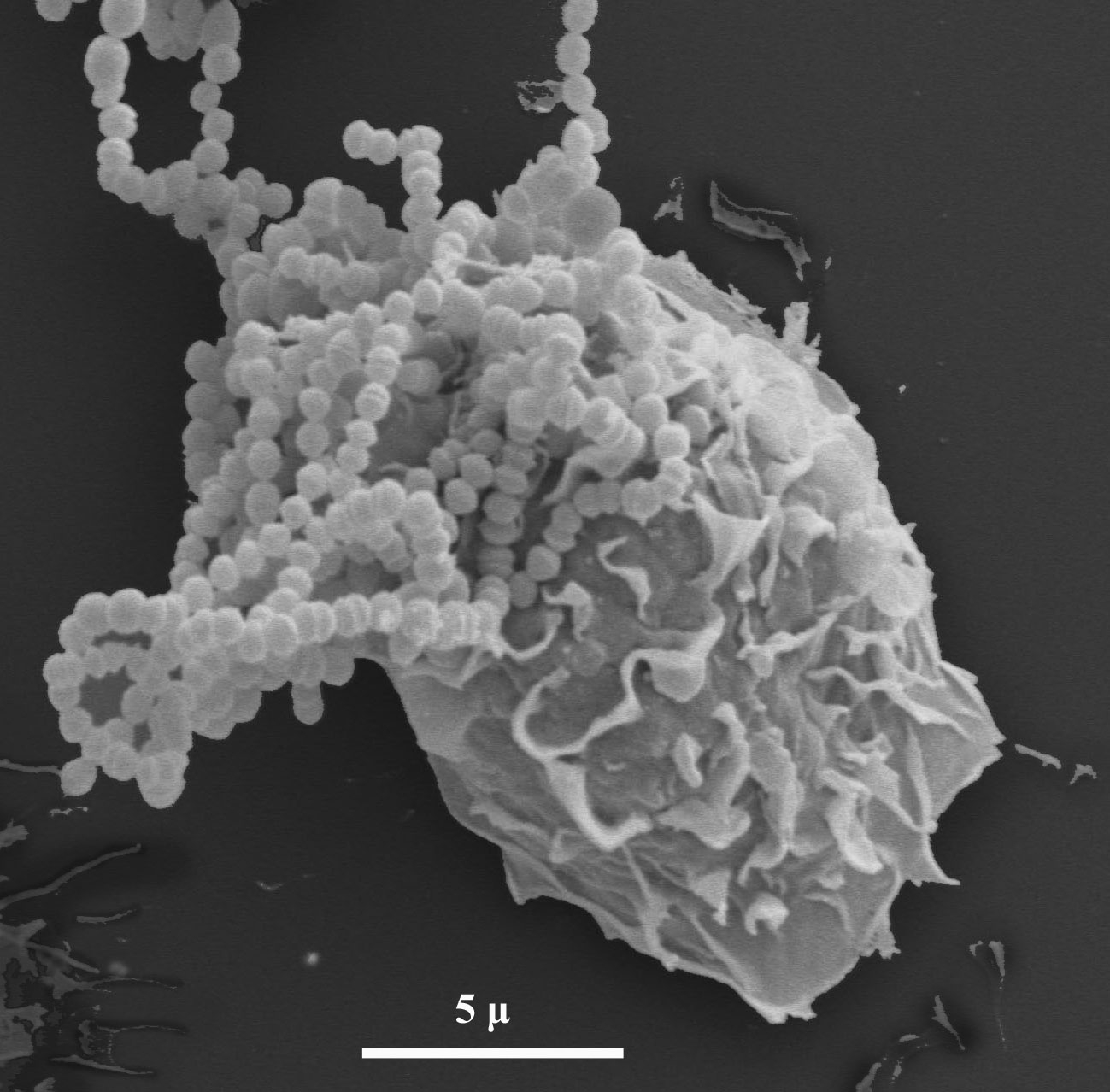
This web page was produced as an assignment for an undergraduate course at Davidson College.
Innate Immune Response

Figure 3. Chains of S. pyogenes on a macrophage. Taken with a scanning electron micrscope by the Electron Microscopy Research Services, part of the School of Neurology, Neurobiology and Psychiatry of Newcastle University. Copyright 2005. http://www.ncl.ac.uk/facilities/microscopy/index.htm Used with permission.
The term innate immune response refers to the fast-acting non-specific immunological actions of an organism that recognize an infection and attempt to clear it from the organism. The innate immune system can be thought of an organism's front line of defense against pathogens. The most basic aspect of the human innate immune system is the epithelium, which is the tissue that makes up the skin and the linings of the gastrointestinal, respiratory, and urogenital tracts. Using the tight junctions that bind the individual cells tightly together, the epithelium provides a strong physical barrier against invasion of pathogens. Internal epithelium, such as those lining the respiratory tract, also secrete mucus as another physical barrier; the mucus prevents many pathogens from being able to live on the surface of the epithelial cells. Epithelial cells mount a non-specific chemical attack against pathogens; for example, the extremely acidic environment of the stomach prevents many infections. Also, certain cells in the intestines secrete molecules called α-defensins that have antimicrobial properties, and similar molecules called β-defensins, are found in the mouth, urogenital and respiratory tracts, and on the skin.
However, the skin cannot keep out all infectious agents, since a small tear in the skin can allow pathogens to enter the organism. If a pathogen does get through the epithelium, it is usually recognized by cells called macrophages. These cells are mononuclear phagocytes that patrol the body to look for invaders, and thus are often found in more susceptible areas, such as the lungs, connective tissue, and directly below the mucosal layer of the intestines. Macrophages have many receptors on their cell surfaces that recognize common pathogenic markers, such as bacterial lipopolysaccharide and lipteichoic acids (found on Gram-negative bacterial walls). When one of these receptors is activated, the macrophage envelopes the pathogen and internalizes it in a process called phagocytosis. Once the pathogen is inside a vesicle in the macrophage, the lysozome, a vesicle containing many different substances, such as nitric oxide, hydrogen peroxide, and superoxide, fuses with the vesicle containing the pathogen. These substances then destroy the pathogen. Other cells, such as neutrophils (also called polymorphonuclear leukocytes), also phagocytose pathogens as part of the innate immune response. When a macrophage is activated through certain receptors, it also secretes chemicals called cytokines that recruit other phagocytes to the site of infection. Some of these chemicals cause inflammation, which has two major immunological functions: bringing other effector cells to help fight the infection and not allowing the pathogen to get into the bloodstream.
Another aspect of the innate immune response is the activation of the complement system, an enzymatic cascade. In this cascade, one enzyme binds to the pathogen and then activates the next enzyme in the cascade, which in turn activates the next enzyme, etc. There are three main outcomes of the complement cascade: 1) more inflammatory cells are signaled to come to the site of infection 2) the pathogen is opsonized, meaning that it the pathogen surface is coated in proteins that signal phagocytes to engulf and destroy the pathogen 3) the pathogen is directly killed. The complement cascade can lead to the direct killing of a pathogen via the formation of the membrane-attack complex on the pathogen surface. The membrane-attack complex is formed with many 10-16 molecules of the complement protein C9 polymerize to form a pore in the membrane of the pathogen. This pore allows many molecules to enter and exit the pathogen, disrupting homeostasis and killing the pathogen (Janeway et al. 2005).
The physical barriers, namely the skin and the mucus of certain surfaces, of the innate immune system are usually enough to prevent infection by S. pyogenes. As such, Streptococcus pyogenes infections are normally secondary infections. Once S. pyogenes enters the organism and is phagocytosed, it is easily killed. Unlike many other pathogens, S. pypogenes does not produce chemicals, such as superoxide dismuatse, that inactivate the toxic chemicals in the lysozome. Voyich et al. report that in an in vitro experiment, approximately one-third of opsonized streptococci were phagocytosed by polymorphonuclear lymphocytes after only 30 minutes (2003). However, GAS does have many different defense mechanisms that enable it to evade the innate immune response (see Evasion of the Immune System for more information).
Return to S. pyogenes homepage
Davidson College Biology Home Page
Send any comments or concerns to beenglish@davidson.edu
© Copyright 2007 Department of Biology, Davidson College, Davidson, NC 28035